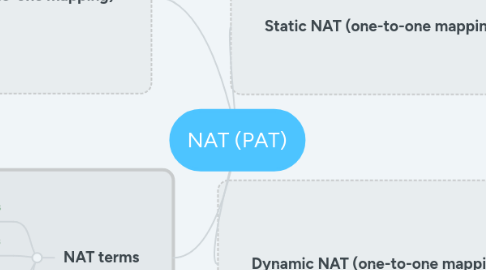NAT (PAT)
da Александр Иванов


1. PAT (NAT Overloading) (many-to-one mapping)
1.1. Configure a standard access list to define what internal traffic will be translated
1.1.1. RouterA(config)# access-list 1 permit 192.168.0.0 0.0.0.255
1.2. Link the access list to the interface to be used for PAT
1.2.1. RouterA(config)# ip nat inside source list 1 interface fa0/0 overload
1.3. Define interfaces as either inside or outside
1.3.1. R0uter(config-if)#ip nat inside (or ip nat outside)
2. NAT terms
2.1. Inside local address
2.2. Inside global address
2.3. Outside local address
2.4. Outside global address
3. Static NAT (one-to-one mapping)
3.1. Define the router’s interfaces as inside or outside:
3.1.1. R0uter(config-if)#ip nat inside (or ip nat outside)
3.2. Define static mapping between the inside address and the outside address:
3.2.1. R0(config)#ip nat inside source static 10.0.0.1 200.0.0.2
4. Dynamic NAT (one-to-one mapping)
4.1. Define a pool of addresses (public IP) to be used for dynamic NAT allocation
4.1.1. Router(config)#ip nat pool pool_name start_ip end_ip { netmask netmask | prefix-length prefix-length }
4.2. Configure a standard access control list to define what internal traffic will be translated
4.2.1. Router(config)#access-list access-list-number permit source [source-wildcard]
4.3. Link the access list to the NAT pool
4.3.1. Router(config)#ip nat inside source list access-list-number pool pool_name

